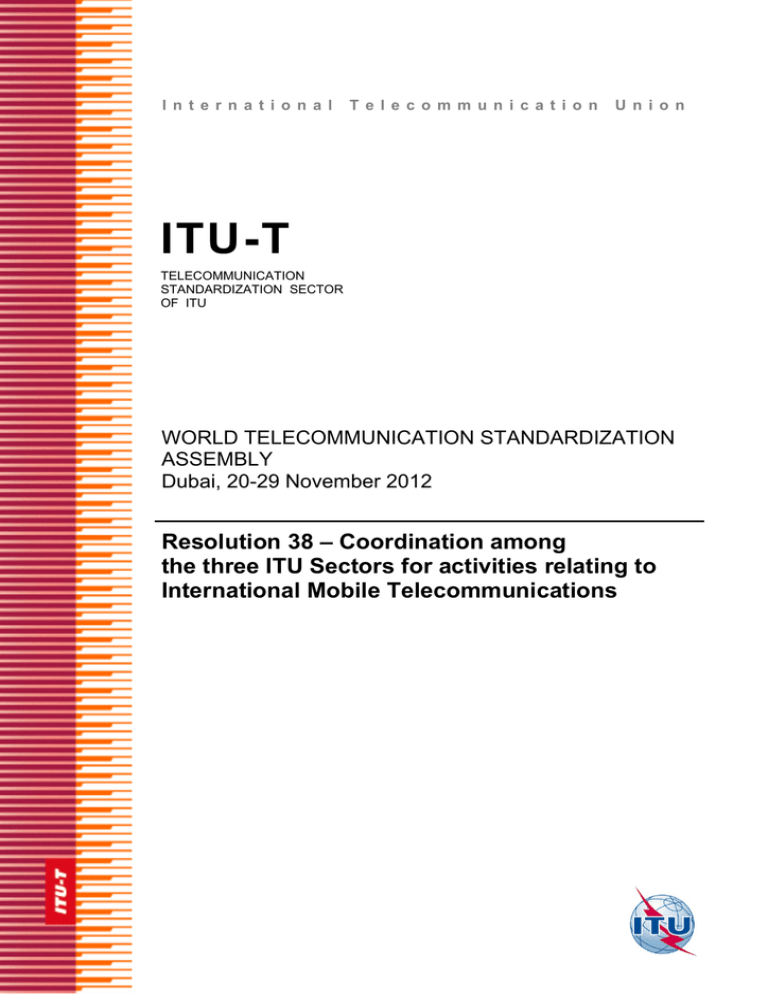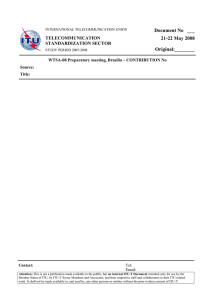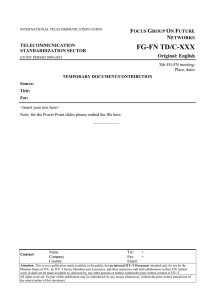
I n t e r n a t i o n a l
T e l e c o m m u n i c a t i o n
U n i o n
ITU-T
TELECOMMUNICATION
STANDARDIZATION SECTOR
OF ITU
WORLD TELECOMMUNICATION STANDARDIZATION
ASSEMBLY
Dubai, 20-29 November 2012
Resolution 38 – Coordination among
the three ITU Sectors for activities relating to
International Mobile Telecommunications
FOREWORD
The International Telecommunication Union (ITU) is the United Nations specialized agency in the field of telecommunications. The ITU Telecommunication Standardization Sector (ITU-T) is a permanent organ of ITU. ITU-T is
responsible for studying technical, operating and tariff questions and issuing Recommendations on them with a view to
standardizing telecommunications on a worldwide basis.
The World Telecommunication Standardization Assembly (WTSA), which meets every four years, establishes the
topics for study by the ITU-T study groups which, in turn, produce Recommendations on these topics.
The approval of ITU-T Recommendations is covered by the procedure laid down in WTSA Resolution 1.
In some areas of information technology which fall within ITU-T's purview, the necessary standards are prepared on a
collaborative basis with ISO and IEC.
ITU 2013
All rights reserved. No part of this publication may be reproduced, by any means whatsoever, without the prior written
permission of ITU.
RESOLUTION 38 (Rev. Dubai, 2012)
Coordination among the three ITU Sectors for activities relating to
International Mobile Telecommunications
(Montreal, 2000; Florianópolis 2004; Johannesburg, 2008, Dubai, 2012)
The World Telecommunication Standardization Assembly (Dubai, 2012),
considering
a)
that the International Telecommunication Standardization Sector (ITU-T) is actively continuing its
studies on mobility and overall network aspects of International Mobile Telecommunications (IMT);
b)
that Study Group 5 of the ITU Radiocommunication Sector (ITU-R) has the ITU-R responsibility
for the development of IMT;
c)
that the first session of the Conference Preparatory Meeting (CPM15-1) for the 2015 World
Radiocommunication Conference (WRC-15) established the Joint Task Group (JTG) 4-5-6-7 responsible for
the development of draft CPM text under WRC-15 agenda items 1.1 and 1.2, related to spectrum
identification for IMT-based systems;
d)
that the ITU-T study groups involved in the standardization of IMT and ITU-R Study Group 5 have
had, and continue to have, effective informal coordination via liaison activity with respect to development of
Recommendations relating to IMT for both Sectors;
e)
that Resolution ITU-R 50-2 (Geneva, 2012) of the Radiocommunication Assembly (RA), on the
role of the Radiocommunication Sector in the ongoing development of IMT, invited ITU-T to draw up a
complementary roadmap for all activities relating to IMT and to coordinate it with ITU-R so as to ensure full
alignment and harmonization of the work programmes of both ITU-T and ITU-R;
f)
that Resolution ITU-R 17-4 (Geneva, 2012) of RA requests the Secretary-General, in coordination
with the Directors of the Radiocommunication Bureau (BR), Telecommunication Standardization Bureau
(TSB), and Telecommunication Development Bureau (BDT), to continue promoting the adoption of
appropriate measures so that all countries, especially developing countries1, might more adequately plan the
structured integration of IMT systems into their current public networks;
g)
that the development of a roadmap for each Sector to independently manage and advance its work
on IMT within a complementary framework is an efficient means of achieving progress in both Sectors, and
that such a roadmap concept facilitates the communication of issues relating to IMT with organizations
external to ITU;
h)
that Resolution 43 (Rev. Hyderabad, 2010) of the World Telecommunication Development
Conference (WTDC) resolved to include, as a priority, support for IMT implementation in developing
countries;
____________________
1
These include the least developed countries, small island developing states, landlocked developing countries and
countries with economies in transition.
WTSA-12 – Resolution 38
1
i)
that Study Group 2 of the ITU Telecommunication Development Sector (ITU-D) is currently
involved in activities closely coordinated with ITU-T and ITU-R in order to identify the factors influencing
the effective development of broadband, including IMT, for developing countries;
j)
that it is of the utmost importance to roll out IMT networks in order to develop the broadband plans
that a substantial number of countries have started,
noting
a)
Resolution 18 (Rev. Dubai, 2012) of this assembly, on principles and procedures for the allocation
of work to, and coordination between, ITU-R and ITU-T;
b)
Resolution 59 (Hyderabad, 2010) of WTDC, on strengthening coordination and cooperation among
the three ITU Sectors on matters of mutual interest;
c)
Recommendation ITU-T A.4, on the communication process between ITU-T and forums and
consortia;
d)
Recommendation ITU-T A.5, on generic procedures for including references to documents of other
organizations in ITU-T Recommendations;
e)
Recommendation ITU-T A.6, on cooperation and exchange of information between ITU-T and
national and regional standards development organizations;
f)
IMT,
Resolutions ITU-R 47-2, 50-2, 56-1 and 57-1, on the role of ITU-R in the ongoing development of
resolves
1
that ITU-T maintain a roadmap for all of its standardization activities relating to IMT;
2
that the effective coordination currently established between ITU-T, ITU-R and ITU-D for activities
relating to IMT be continued so as to ensure full alignment and harmonization of the work programmes,
including the roadmaps, of the three Sectors,
instructs the Director of the Telecommunication Standardization Bureau
to bring this resolution to the attention of the Directors of BR and BDT,
encourages the Directors of the three Bureaux
to investigate new ways to improve the efficiency of ITU work on IMT.
2
WTSA-12 – Resolution 38



